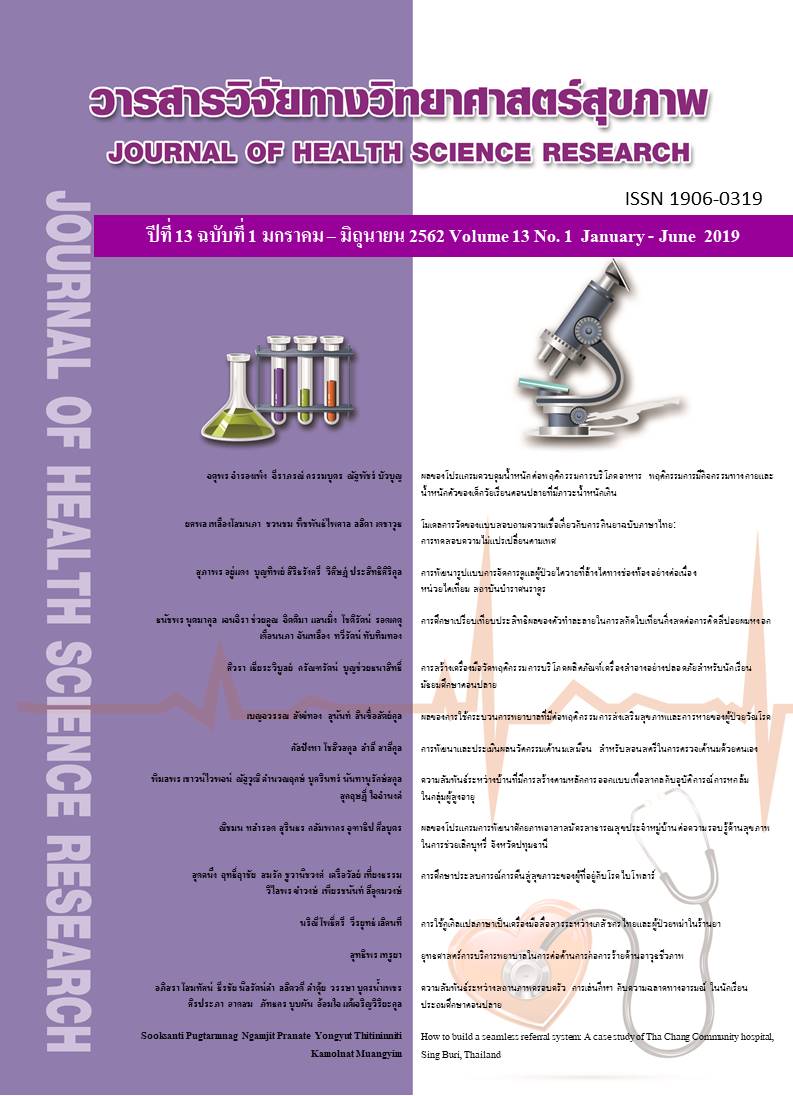การสร้างระบบส่งต่อที่ไร้รอยต่อ : กรณีศึกษาโรงพยาบาลท่าช้าง จังหวัดสิงห์บุรี
Main Article Content
บทคัดย่อ
ภาระงานที่เพิ่มมากขึ้น การขาดแคลนผู้ดูแล และค่าใช้จ่ายด้านสุขภาพที่สูงขึ้นเรื่อยๆของการให้บริการดูแลผู้ป่วยติดเตียง ที่ยังไม่สามารถทำให้ผลการรักษาดีขึ้นได้ กลายเป็นภาระที่หนักอึ้งของทั้งผู้ให้บริการสาธารณสุขและสมาชิกในครอบครัวของผู้ป่วย
การศึกษานี้เป็นวิจัยเชิงคุณภาพ เครื่องมือคือการสัมภาษณ์เชิงลึก กลุ่มเป้าหมาย 12 คนถูกเลือกอย่างเจาะจง จาก 4 กลุ่ม คือ เจ้าหน้าที่ของโรงพยาบาลท่าช้าง โรงพยาบาลส่งเสริมสุขภาพตำบล อสม. และครอบครัวของผู้ป่วย ใช้วิธีการวิเคราะห์เนื้อหา จากข้อมูลที่ได้ จากนั้นผลการศึกษาจาก 4 กลุ่ม จะถูกนำมาทำสามเส้าข้อมูล
ประสิทธิผลของโปรแกรมการส่งต่อของท่าช้าง ประกอบด้วย ผลลัพธ์ทางคลินิกของผู้ป่วย การลดลงของการเข้าโรงพยาบาลซ้ำ การลดลงของความผิดพลาดในการสื่อสาร และ การลดลงของความล่าช้าของการดูแลผู้ป่วยหลังออกจากโรงพยาบาล ปัจจัยแห่งความสำเร็จในระบบการสร้างต่อที่ไร้รอยต่อของอำเภอท่าช้างคือ กลยุทธ์ “การออกจากโรงพยาบาลอย่างมีคุณภาพ” ที่ใช้ “กระบวนการประชุมข้างเตียงผู้ป่วย” บุคคลที่เป็นกลไกหลักแห่งความสำเร็จของระบบส่งต่อที่ไร้รอยต่อของอำเภอท่าช้างคือ “ผู้ดูแลผู้ป่วยที่บ้าน” ผนวกกับเทคนิคการสอนงาน การช่วยเหลือสนับสนุน และ การเสริมจาก “ทีมงานคู่หู” การสร้างระบบส่งต่อที่ไร้รอยต่อนั้นต้องประกอบไปด้วยการไร้รอยต่อของ เจ้าหน้าที่ ข้อมูล ยาและเวชภัณฑ์ การเดินทาง แบบลงข้อมูลการส่งต่อ ทักษะการดูแลรักษาผู้ป่วย และ บริการดูแลรักษาผู้ป่วย
Downloads
Article Details
บทความที่ได้รับการตีพิมพ์เป็นลิขสิทธิ์ของวิทยาลัยพยาบาลบรมราชชนนี จังหวัดนนทบุรี
ข้อความที่ปรากฏในบทความแต่ละเรื่องในวารสารวิชาการเล่มนี้เป็นความคิดเห็นส่วนตัวของผู้เขียนแต่ละท่านไม่เกี่ยวข้องกับวิทยาลัยพยาบาลบรมราชชนนี จังหวัดนนทบุรี และคณาจารย์ท่านอื่น ในวิทยาลัยฯ แต่อย่างใด ความรับผิดชอบองค์ประกอบทั้งหมดของบทความแต่ละเรื่องเป็นของผู้เขียนแต่ละท่าน หากมีความผิดพลาดใด ๆ ผู้เขียนแต่ละท่านจะรับผิดชอบบทความของตนเองแต่ผู้เดียว
เอกสารอ้างอิง
2. Nakakul N. Seamless referral system and patient safety. Lampang: Lampang Hospital; 2013.
3. Messina FC, McDaniel MA, Trammel AC, Ervin DR, Kozak MA, Weaver CS. Improving specialty care follow-up after an ED visit using a unique referral system. Am J Emerg Med [Internet]. 2013;31(10):1495–500. Available from: https://dx.doi.org/10.1016/j.ajem. 2013. 08. 007
4. Caldwell PH, Arthur HM. The influence of a “culture of referral” on access to care in rural settings after myocardial infarction. Heal Place. 2009;15(1):180–5.
5. Elson R, Cook H, Blenkinsopp A. Patients’ knowledge of new medicines after discharge from hospital: What are the effects of hospital-based discharge counseling and community-based medicines use reviews (MURs)? Res Soc Adm Pharm [Internet]. 2017;13(3):628–33. Available from: https://dx.doi.org/ 10.1016 /j. sapharm.2016.05.001
6. Celenza JF, Zayack D, Buus-Frank ME, Horbar JD. Family involvement in quality improvement: from bedside advocate to system advisor. Clin Perinatol. 2017;44(3):553–66.
7. Surmaitis RM, Amaducci A, Henry K, Jong M, Kiernan EA, Kincaid H, et al. Perception and practice among emergency medicine health care providers regarding discharging patients after opioid administration. Clin Ther [Internet]. 2018;40(2):214–23.e5 Available from: https://dx. doi.org/10.1016/j.clinthera.2018.01.001
8. Ritchie CS, Leff B. Population health and tailored medical care in the home: the roles of home-based primary care and home-based palliative care. J Pain Symptom Manage [Internet]. 2018;55(3): 1041–6. Available from: https://doi.org/10.1016/j.jpainsymman.2017.10.003
9. Kennelty KA, Chewning B, Wise M, Kind A, Roberts T, Kreling D. Barriers and facilitators of medication reconciliation processes for recently discharged patients from community pharmacists’ perspectives. Res Soc Adm Pharm [Internet]. 2015;1–14. Available from:https://dx.doi.org/10.1016/j.sapharm.2014.10.008


